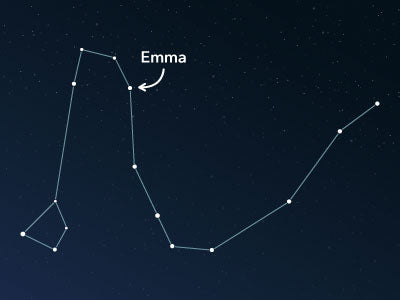The constellation Draco
Characteristics
- Other names / Symbolism
- Dragon
- Hemisphere
- Northern hemisphere
- Visibility
- All year round
- Area
- 1083 deg²
- Brightest star
- Etamin (HIP number 87833)
- Specialties
- Planetary nebula, galaxies

The Draco, Latin for Dragon, is one of the 48 constellations described by the ancient Greco-Roman astronomer Claudius Ptolemy. It is one of the largest constellations in the night sky and is visible throughout the year north of the equator. In its area are a couple of exciting deep-sky objects.
Hemisphere, visibility, and area
The constellation Draco stretches over the northern sky with an area of roughly 1,083 square degrees, making it the eighth-largest constellation in the night sky. Compared to the constellations in the northern hemisphere only, it is one of the five largest.
For most regions in the northern hemisphere, Draco is circumpolar, meaning it can be observed all year round. However, south of the equator, it is only fully visible up to the first degree of latitude and cannot be seen somewhere else.
Draco's well-known neighbors make locating it in the night sky easy. To the north, it is adjacent to the constellations Camelopardalis and Ursa Minor (also known as the Little Bear). To the south, it is bordered by Ursa Major (also known as the Great Bear), Boötes, Hercules, and the small constellation Lyra. On the west lie the constellations Cygnus and Cepheus.
In star maps, Draco is usually visualized with a long chain of stars, which represents the tail of the dragon and winds toward Ursa Minor. On the other hand, the dragon's head, composed of approximately four stars, faces toward the constellation Hercules.
The brightest star in Draco is Etamin (Latin: γ Draconis, Gamma Draconis). It is also called by its Arabic names Ettanin and Eltanin. It has an apparent magnitude of 2.2 and is about 150 light-years away.
Specialties in the constellation
The constellation Draco is located away from the Milky Way and thus provides optimal conditions for observing some interesting nebula objects. However, professional equipment such as a telescope is necessary.
One interesting object is the planetary nebula NGC 6543 which consists of a star that has shed its outer gas shell at the end of its evolution. At the center of this shell lies an extremely hot white dwarf star. This complex composition gave the nebula its name, the Cat's Eye Nebula. The details and structures can only be seen in long-exposure photographs and appear in a telescope as a diffuse nebula with a star in the center.
The Hubble Space Telescope, developed by NASA and ESA, shows very impressive images of NGC 6543.

In addition, there are three galaxies in the region of Draco. One is M102 (Messier 102), also known as NGC 5866. It is a spiral galaxy about 30 million light-years away. It appears as a small nebulous patch in a telescope.
The other two galaxies are not particularly noticeable.
Mythology
There are several stories about the mythological origin of Draco.
In one version, the constellation represents the hundred-headed dragon Ladon, who guarded the tree of golden apples for the goddess Hera. The golden apples were precious because eating them promised eternal youth and immortality. Ladon remained faithful and vigilant to his task.
Later, Hera gave her stepson Hercules the task of stealing three of the golden apples, hoping he would fail. However, Hercules managed to slay the dragon with poisoned arrows from a safe distance and pick the apples.
As a reward for his loyalty, Hera placed the dragon as a constellation in the sky.
PublishedRead more interesting articles

An overview of all 88 constellations
Learn more about all 88 constellations and read interesting information about the mythology, visibility, and features.

Planetarium App
Discover the night sky with our planetarium app!
Available for iOS and Android.

Name a star in the constellation Draco
Name a star in a constellation and create something that lasts for eternity.